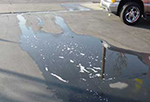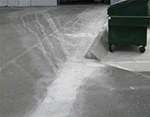 Discharges of wastewater from carpet cleaning, pressure washing, and surface cleaning to the storm drain system. All wastewater must be contained, collected and properly disposed of.
Discharges of wastewater from carpet cleaning, pressure washing, and surface cleaning to the storm drain system. All wastewater must be contained, collected and properly disposed of.
 Improper management of stone-cutting slurry resulting in prohibited discharges and/or conditions. Discharges of slurry to the stormwater drain system from a stone cutting business. Slurry must be properly managed and disposed of.
Improper management of stone-cutting slurry resulting in prohibited discharges and/or conditions. Discharges of slurry to the stormwater drain system from a stone cutting business. Slurry must be properly managed and disposed of.
 Sediment track-out from dirty or unpaved facilities or worksites onto outdoor surfaces and/or public streets. Entrances and exits at unpaved facilities and worksites must be stabilized to prevent tracking of sediment offsite, especially during the wet season. Facilities such as wheel washes may be necessary toclean off tires from leaving vehicles and equipment.
Sediment track-out from dirty or unpaved facilities or worksites onto outdoor surfaces and/or public streets. Entrances and exits at unpaved facilities and worksites must be stabilized to prevent tracking of sediment offsite, especially during the wet season. Facilities such as wheel washes may be necessary toclean off tires from leaving vehicles and equipment.
 Spilled automotive fluids and polluted parts exposed to contact with stormwater. Improper storage of oily automotive parts — resulting in a unmitigated stormwater polluting source. Effective BMPs must be implemented to prevent stormwater contact with pollutants to avoid a prohibited non-stormwater discharge.
Spilled automotive fluids and polluted parts exposed to contact with stormwater. Improper storage of oily automotive parts — resulting in a unmitigated stormwater polluting source. Effective BMPs must be implemented to prevent stormwater contact with pollutants to avoid a prohibited non-stormwater discharge.
 Poor waste and/or material management practices resulting in exposure of pollutants to stormwater or non-stormwater discharges. Hazardous wastes, such as waste gasoline (pictured), and all other pollutants (hazardous or non-hazardous), must be stored in a manner to that does not constitute an unmitigated stormwater pollution source, in addition to being stored so that all hazardous waste requirements are met.
Poor waste and/or material management practices resulting in exposure of pollutants to stormwater or non-stormwater discharges. Hazardous wastes, such as waste gasoline (pictured), and all other pollutants (hazardous or non-hazardous), must be stored in a manner to that does not constitute an unmitigated stormwater pollution source, in addition to being stored so that all hazardous waste requirements are met.
 Poor spill response and spill/release management practices resulting in the accumulation of unattended outdoor spills and releases exposed to stormwater and non-stormwater discharges. Institute effective spill/release management protocols to prevent the accumulation of spilled materials or wastes.
Poor spill response and spill/release management practices resulting in the accumulation of unattended outdoor spills and releases exposed to stormwater and non-stormwater discharges. Institute effective spill/release management protocols to prevent the accumulation of spilled materials or wastes.
 Discharges of wastewater from HVAC and other equipment maintenance. Effective BMPs must be implemented to prevent the discharge of wastewater to the storm drain system.
Discharges of wastewater from HVAC and other equipment maintenance. Effective BMPs must be implemented to prevent the discharge of wastewater to the storm drain system.
